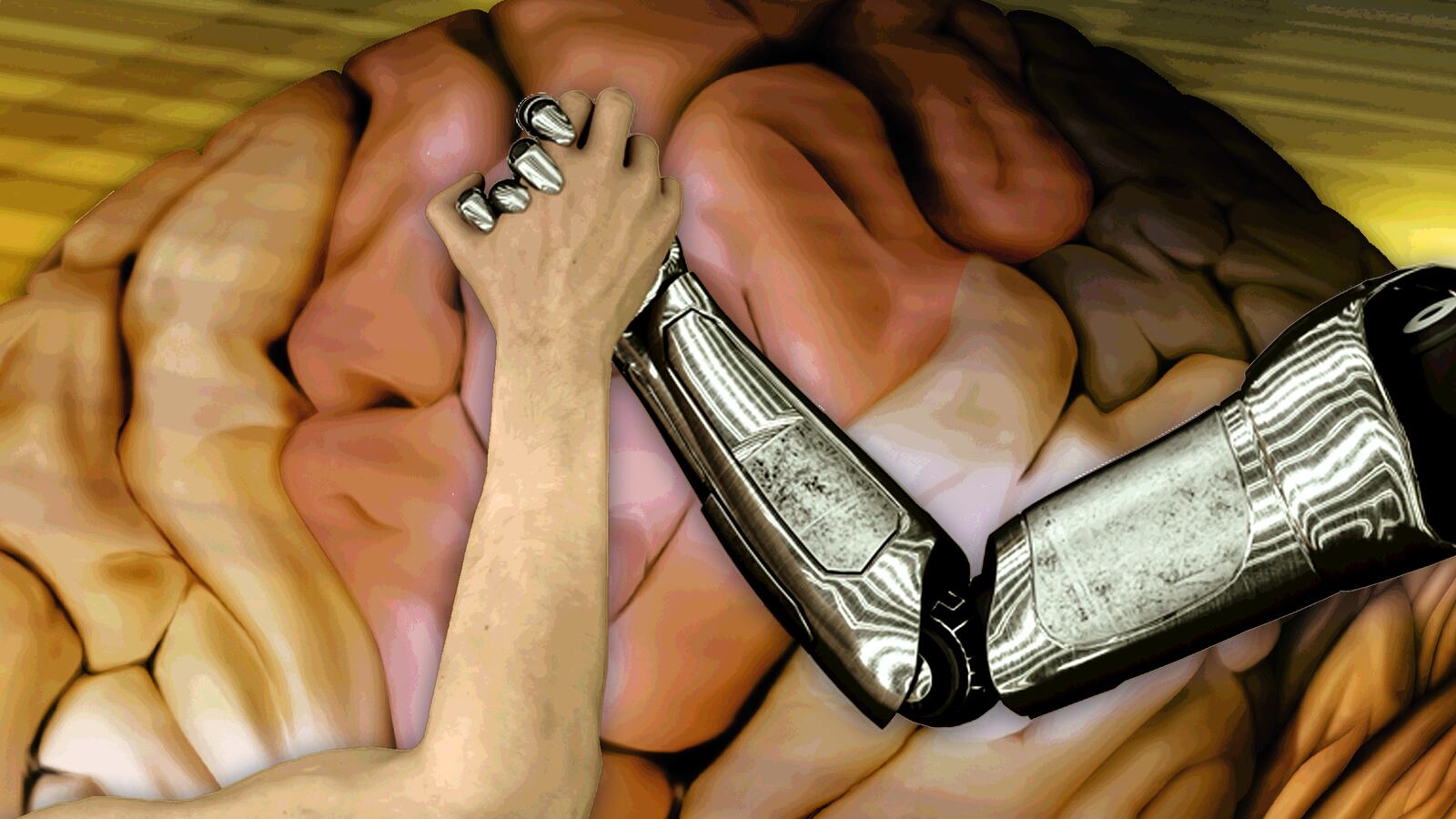Let’s call them Homo muskus. They’re the new species of human-machine hybrids that Elon Musk, the CEO of Tesla and SpaceX, says scientists will need to invent if we want to stay as smart as our gizmos, and the rapidly expanding digital brain.
“Over time I think we will probably see a closer merger of biological intelligence and digital intelligence,” Musk said on stage last month at the World Government Summit in Dubai. This can’t come too soon, he adds. Given the quick transformation that he believes we will experience, it would mean zipping from an age of driverless cars to what he calls an “artificial general intelligence” that is “smarter than the smartest human on earth.”
Musk says this will provoke a “dangerous situation” for mere humans, in part because he believes automation will push unemployment as high as 12 to 15 percent over the next 20 years.
The remedy, he suggests, is twofold. First, Musk advocates paying out a basic universal income to the rising tide of “unemployables”—a condition, he adds, that doesn’t have to be all that bad. “People will have time to do more interesting things,” he told CNBC. “There will be more leisure time.”
Musk’s second tonic for massively disruptive automation is to re-engineer our brains and bodies. “We have to figure out how to integrate in the future with advanced AI,” he said. “Some high-bandwidth interface to the brain… that helps achieve a symbiosis between human and machine intelligence and maybe solves the control problem and the usefulness problem.”
Musk, of course, is on the leading edge of driver-replacement tech with Tesla, which is already semi-automatic, and is morphing into being driverless in just a few years. Which makes his talk about the downsides of job-killing robots baffling to his many admirers—and a bit of a curmudgeon in Silicon Valley on the subject of job losses from AI and automation.
Most of his fellow visionaries making super-smart thingamajigs insist that automation will not massively displace people. They point out this fear has been voiced since the Industrial Revolution, a period in which the opposite has happened. The age of machines has created rafts of new jobs while vastly increasing productivity, although no one knows if this will hold going forward.
As Musk points out, the driverless cars he’s working to build will throw millions of drivers out of work. Millions more may lose out from AI in health care and other fields.
But let’s for a moment assume that Musk is right: that millions more people will be jobless in 2037. How realistic is what he is proposing as a solution?
I’ll let economists opine on a universal basic income, which I assume would come from all of the money being made by robots. Yet it’s unclear to me who would be buying whatever they’re making if more of Earth’s humans aren’t working.
I’ll also defer to a future column the observation that the lucky humans with the best jobs—those newly minted Homo muskus—might have little or no interest in their stupider and slower sapiens cousins.
So let’s focus on whether the idea of a hybrid bionic species is possible with current or near-term technologies. How close—or far—are we from being able to bioengineer people to have, say, an IQ-equivalent of 300? Or bio-hybrids that can at least keep up with the processing speed, and the access to data and searches, that computers right now do much better than pre-enhanced humans?
Also, what would Homo muskus look like? Are we talking Borgs bristling with hardware, and infused with nanoprobes; a plug mounted in the back of their heads that would allow them to download data like Johnny Mnemonic; or something more benign?
To find out, I asked three experts deep into efforts to augment the human brain. All three, it’s important to point out, are working to boost people with damaged, diseased, or aging brains or bodies, not to turn healthy people into super-enhanced cyborgs.
Brown University neuroscientist John Donoghue has developed a neural translation system called BrainGate that uses electrodes surgically implanted into the motor cortex of a paralyzed patient’s brain, allowing them to operate prosthetic arms using just their thoughts. The imbedded sensors “read” the electric signals from neurons firing when the patient thinks “move arm to the left.” The highly experimental BrainGate has only been tried on a few people, including a woman paralyzed for 13 years who used the technology to pick up a coffee mug with an artificial arm and to sip some joe by using thought.
“The bandwidth and reliability of brain interfaces is still quite a bit lower than what nature gave us—hands, voice, and ears,” said Donoghue. “The technology needed to get full information for high-bandwidth brain-machine communication is either beyond technology or beyond current understanding of how the brain works.”
Neurosurgeon-turned-venture capitalist Andrew Firlik is more enthusiastic about the possibilities. “Yes! We agree with Elon,” he said, “we” being his firm, Jazz Venture Partners, based in San Francisco.
“Not only is what Elon saying possible, it’s inevitable and is happening right now,” said Firlik, whose fund supports brain-boosting and neural-gaming technologies using external electrodes, virtual reality, and other devices and techniques.
“As technology is becoming more omnipresent and immersive, it is actively shaping our brains and unlocking our full potential,” he added. “A new wave of ‘experiential technology’ is using the natural pathways into the brain—eyes, ears, touch… our full sensorium—to close the loop between computer systems and the human brain.
“The more sophisticated AI becomes, the more we will be able to harness experiential technologies to maximize the biologic capabilities of our brains. While some may think of this as hard to contemplate or scary, it is really no different from how we have historically used advances in information technology in society up until now to cure diseases, enhance communication, or create new modalities of transportation or commerce.”
UCSF neurologist Adam Gazzaley, who also serves as chief scientist for Jazz, is somewhere in between. “I believe that he [Musk] is pushing for invasive brain-computer interfaces,” he said. “I agree that we need to use tech to enhance cognitive function, but my bias is that few people will be willing (or should) have neurosurgery to accomplish this. We can accomplish much more in this domain with noninvasive approaches (such as Virtual Reality, videogame training, and brain stimulation), and with the potential for positively impacting way more people.”
We seem to be at a fulcrum where parts of this cyborg future may one day actually occur, and parts of that are already here in a nascent state. Yet we don’t know exactly where or when a leap into Homo muskus might happen. Clearly, if Musk is right about jobs in a few decades, we might want to consider the possibility of evolving alongside our machines. Or maybe about some of us going to Mars, another project of Musk’s, although it’s not clear if the machines will be any less smart or pervasive on the Red Planet.
Still, as John Donoghue said, you never know when a genius will show up and radically change everything. He also believes that it’s helpful to see visionaries like Musk “draw a line in the sand to challenge the science and engineering community to deliver on a really hard task.”
“I’d also like to see Musk fund this,” he added.






